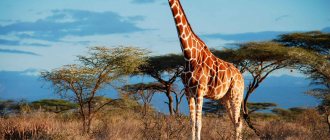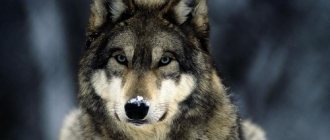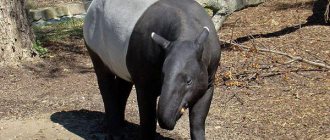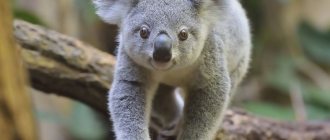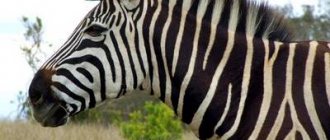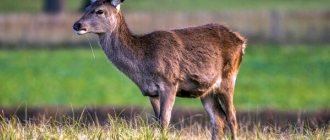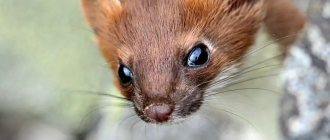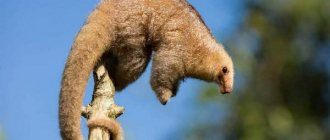- Lifespan
The giraffe is big - he knows better. V. Vysotsky.
The animal giraffe is one of the most colorful representatives of the animal world of our planet. If only because the giraffe is the longest and tallest animal on Earth, there is no one taller than it. Moreover, a third of the giraffe’s growth occurs in its neck, needless to say, the giraffe’s neck is the longest in the world. Read on to learn about the habits of giraffes, how they live, sleep and eat (and given their length, this is quite a task).
Description
Giraffes are the tallest animals in the world, harmoniously combining body length with impressive mass.
They are quite large and rival bulls in body weight. On average, their weight ranges from 800-900 kg, but some representatives of the species can reach 1200 kg. Females usually weigh slightly less than males. The height of a giraffe is approximately 6 meters, which is the size of a two-story house. About 1/3 of the body is occupied by the giraffe's neck. It is formed from 7 vertebrae: this principle of body structure is characteristic of mammals.
The name of the animal in scientific language sounds like camelopardalis. It was invented in ancient Rome and is a combination of the Latin words camel and leopard. The name was due to the fact that giraffes turned out to be as large as camels and spotted like leopards.
Giraffe in natural habitat
Ostrich
The ostrich grows up to 2.7 m.
The tallest bird in the world is the ostrich. It grows up to 2.7 m and weighs 156 kg. Ostriches do not fly, but they run quickly on the ground, reaching speeds of up to 70 km/h or taking steps up to 4 m long. This bird has a long neck, a flat head and large eyes protected by eyelashes. The curly, loose feathers can be black, white or grey.
Appearance
The giraffe amazingly copes with the physical stress that occurs when raising and lowering its head. His heart is located three meters below his head and at a height of about two meters from the ground. Because of this, the giraffe's legs should swell greatly due to blood pressure, but in reality this does not happen. The anatomy of a giraffe is designed in such a way that blood circulates normally throughout the body, which is explained by the following points:
- At the location of the main vein, which is in the neck, there are shut-off valves that allow you to regulate the pressure in this area and maintain optimal levels.
- Giraffe blood is thick, which is due to the density of red blood cells. This allows the animal to actively move and raise its head without compromising its well-being.
- The mammal has a large and powerful heart. Its weight can reach about 12 kg. This size helps pump approximately 60 liters of blood every minute, which generates pressure levels three times higher than in humans.
All this helps the animal maintain excellent health during physical activity.
On the head of a giraffe there are ossicones - small protrusions resembling horns. They are covered with leather, on top of which there is wool. In females, the ossicones are thinner and complemented by tassels. Sometimes in the center of the forehead there is a bone growth that looks like another horn. Giraffes' ears are quite neat. Their eyes are black in color and surrounded by many eyelashes. The animals have a short mane on their necks.
Appearance of ossicones
The giraffe has a unique tongue: it is dark in color with a purple tint, and its length reaches almost 50 cm. On the lips of the animal there are sensors in the form of short hairs that help assess the degree of maturity of plants and dangerous elements on them, which may include thorns.
There are nipples along the edges of the lips, thanks to which the giraffe can hold leaves and other plants. In this he is helped by the lower incisors and a surprisingly flexible tongue, capable of folding in a special way. Thanks to this property, it can grasp food so as to bypass the spines and immediately pull up the food.
The animal is entirely covered with short hair. Below is a tail, about a meter long, ending in a black tassel. A distinctive feature of its appearance, its spotted pattern, helps the animal camouflage itself. This coloration is designed to blend in with the shadows that appear in the treetops, making the giraffe more difficult to recognize. At the same time, the lower part of the body does not have such spots and looks lighter.
The spotted pattern of giraffes is absolutely unique: it is impossible to find two identical patterns. In this it is similar to human fingerprints.
Kangaroo
The body length of a giant kangaroo is 2.5-2.8 m.
Kangaroos have a powerful, muscular build and are able to jump long distances. Among modern animals there are both large and small species (wallabies). The tallest among them was Procoptodornus, which became extinct about 40 thousand years ago. His height reached 3 m, and his weight was 200 kg. Among modern kangaroos, the largest is the giant kangaroo. The length of its body from the tip of its nose to its tail is 2.5-2.8 m, and its weight can reach 80 kg.
Almost all tall animals live in hot climates and feed on plants and fruits. They are incredibly beautiful and strong.
Lifestyle
Recommended by topic
Fox Panda Lynx
The giraffe is endowed with excellent vision and hearing. This helps him notice the approach of the enemy and control the condition of his relatives. The viewing area of these mammals reaches 1 kilometer. These animals rest most of the day, but at the same time they carefully monitor their territory, reacting to any dangers.
Giraffes sleep little: the maximum they need to sleep is about four hours a day. However, on average they sleep only two hours, and sometimes the total amount of time spent sleeping is 20 minutes. At night, mammals sleep lying down, bending their neck so that their head rests on the lower part of their hind limbs. They take this position quite quickly, lowering themselves first to the chest and then to the stomach. This position resembles an arch in appearance and allows you to quickly mobilize in case of danger.
Giraffes sleep in this position
Giraffes get up early and prefer to have a hearty breakfast in the morning. At the same time, throughout the day they like to chew gum, resting in the shade of trees. At such moments, giraffes relax and are a little half asleep. However, their feelings are still very keen. Despite the half-closed eyes, the ears are constantly perked up and detect the slightest changes around.
Mammals are quite capable of dozing off during the day, but they do this in an upright position. The giraffe's strong neck muscles help the giraffe stay in this position, allowing it to doze while standing for several minutes.
Elena
Ask a Question
Question to the expert
Can giraffes touch the ground with their heads?
Despite having a long neck, the giraffe cannot fully reach the ground. To do this, he needs to perform very complex manipulations: spread his legs wide and bend his knees. This posture can cause injury.
During moments of physical activity, animals can gallop, although this happens quite rarely. They can endure such an active pace for no more than 3 minutes. Despite the short duration of the race, animals can accelerate to a speed of 45-50 km/h and jump over obstacles up to two meters high. Basically, giraffes move at a slow pace and prefer measured walking.
Giraffe walking
At short distances, giraffes can even outrun a racehorse.
Due to their heavy weight and thin legs, mammals can only walk on hard surfaces. For this reason, they avoid swampy areas. Rivers and other bodies of water become an insurmountable obstacle for them.
Polar bear
Standing by its hind legs, the polar bear will reach a height of 3.4 m.
Polar bears are larger than their brown relatives. The height of a polar bear at the withers exceeds 1.5 m. Standing by its hind legs, this animal will reach a height of 3.4 m. These animals weigh about 500–1000 kg. Female bears are slightly smaller than males. The hairs of its fur are hollow from the inside, thanks to this they retain heat perfectly, allowing only ultraviolet rays to pass through. The soles of their paws are also covered with fur, so the bears do not slide on the ice. Polar bears have webbed feet, so they are excellent swimmers and love to spend time in the water.
Internal organization
Giraffes live in colonies consisting of several individuals. One colony can have up to 20 members. This includes females and young offspring. Usually they scatter across the area, but after a while they unite in open space. Mothers are always close to their children, but other members of the colony can leave at any time.
A colony of giraffes gathers in an open area
The number of members of one family is determined by the available food supply. If it is the rainy season, the colony can expand to its maximum as it is provided with sufficient food. If there is currently a period of drought, a colony is formed from a minimum number of members.
Giraffes do not have a clear main leader. However, older and more experienced males dominate younger and weaker males. If two males meet, a fight can easily occur between them, during which they try to hit their opponent with their heads on the neck. In this case, the losing male is not kicked out of the herd, as happens with other species of mammals.
Communicating with each other
Giraffes communicate with their relatives using infrasound transmitted at a special frequency. If animals behave more loudly: they begin to grunt or snort, this serves as a signal of danger that has alarmed them. At the same time, mothers often communicate with their children using whistles. If the child is lost, they try to find him by roaring. When communicating, babies make sounds similar to meowing or bleating.
Giraffes make virtually no sounds, which is why they are considered one of the quietest mammals.
Reproduction
Giraffes are among the polygamous mammals, with males jealously protecting females from others. The period of sexual maturity for females occurs at 3-4 years, but they do not reproduce after that for another year. For males, this indicator occurs at 4-5 years, but they do not reproduce until they are seven years old.
When two sexually mature individuals meet, the courtship period proceeds as follows:
- The male slowly approaches the female, giving her the opportunity to get used to his presence.
- He studies the smell of her urine to determine how ready the female is to mate and conceive offspring.
- During courtship, the male rubs his head in the sacrum area and then places his head on the female's back.
- If the chosen one reacts favorably to such courtship, she allows her tail to be licked, and then puts it aside.
Recommended by topic
Squirrel Salamander Leopard
The conception of offspring occurs during the rainy season. In Africa this is the period from July to September. In females, pregnancy lasts approximately 450 days, and breeding periods occur every 20-30 months.
Females give birth in a vertical position, which causes the baby to fall to the ground from a height of about two meters.
Most often, one cub is born; twins are extremely rare. The weight of a newborn is about 50-100 kg, and its height varies around 150-200 cm. Within an hour after birth, babies get up on their own and reach for milk from their mother.
The cubs are born without horns; instead, they have dark hair on the head, under which there is cartilage. Over time, the cartilage hardens and turns into characteristic horns that grow as they grow older. Black wool remains for several years, after which it disappears.
Caring for offspring
For most of the first week of life, babies hide until they adapt to the world around them. They are allowed into the main part of the herd only after a few weeks. At this time, they are ready to start eating plant foods, although mother's milk is included in their diet until almost a year. Newborn females remain in contact with their mother for 12 to 16 months, males for 12 to 14 months. At the same time, females more often remain in the colony, while adult males usually become loners until the appearance of their own herd.
Mom takes care of the baby
Giraffes have a kind of nursery where you can “hand over” a child 3-4 weeks after its birth. This helps mothers go in search of food and water without fear of traveling up to 200 meters away. At this time, other female mothers take turns looking after the offspring. A prerequisite is the mother's return before dark. They return to the babies, feed them and protect them from predators.
The problem of predation is very common in giraffe herds. Thus, up to 50% of babies become prey for the natural enemies of these mammals, despite the efforts of their mothers.
What does it eat?
The main food for giraffes is the foliage of trees and shrubs, but acacia is considered their favorite delicacy. The “competition” between these two takes place over millions of years of evolution, during which both opponents adapt to each other. The tree has thorns, hooks, thorns and a high percentage of toxic substances with a pungent taste, and the giraffe has a long tongue with many receptors, especially thick saliva with a huge amount of enzymes that can digest even cactus thorns, a liver that produces poison-neutralizing substances and skills recognition of the most caustic leaves. The appearance of the tree is also attractive, on which, at the end of the drought, white flowers appear with a pleasant smell, attracting all the animals in the area, including giants.
The black acacia deserves special attention, as it has even learned to reproduce with the help of these animals. During evolution, sharp thorns appeared on it, but the flowers still remained defenseless, which allows giraffes to eat them without any problems. When the world's tallest animals eat flowers at a height of four meters, they are covered from head to neck in pollen, which is then carried to many other trees. Thus, the acacia does not lose much of its population and continues to exist, reproducing with the help of its “enemy.”
How long do giraffes live?
Under natural conditions, giraffes can live no more than 25 years. But in nature reserves and zoos their life expectancy increases to 30 years. These mammals first arrived in Roman and Egyptian zoos around 1500 BC. Giraffes reached European zoos only at the beginning of the 20th century. They were brought there on sailing ships, and then taken overland. To prevent injury to the hooves, the giraffes wore sandals made of leather and hid them from the rain with a special cloth to keep the animals safe.
Question to the expert
How much does a giraffe's neck weigh?
The neck, as the longest part of the giraffe, can take up about a third of the total mass. So, with an average weight of 850 kilograms, the neck can weigh up to 250 kilograms.
Giraffes are one of the few species of animals that thrive in captivity. Staying in nature reserves not only increases their life expectancy, but also creates a favorable environment for regular breeding of offspring.
Brown bear
Bears grow up to 2–3 m at the withers
There are many species of brown bears in the world, which differ from each other in size. Bears grow up to 2–3 m at the withers and weigh about 200–600 kg. If a bear stands on its hind legs, its height can reach 10 m. Bears live in forests. These animals are omnivores, about 75% of their diet consists of plant foods. The tallest and largest representative of brown bears is the grizzly bear.
Types of giraffes
All varieties of giraffes are distinguished by the presence of a specific color, which is determined by their habitat. There are nine species of giraffes in total:
| View | Habitat | External characteristics |
| Nubian giraffe | Eastern South Sudan, southwestern Ethiopia. | The presence of characteristic chestnut spots framed by white lines, pronounced bone growth. |
| Reticulated (Somali) giraffe | Northeast Kenya, south Ethiopia and Somalia. | The pattern on the body consists of pointed spots of a reddish-brown hue, separated by white lines; a bony growth is present only in males. |
| Angolan giraffe | Northern Namibia, southwestern Zambia, western Zimbabwe. | On the body there are large brown spots with teeth, there is a white patch of skin in the area of the ears. |
| Kordofan giraffe | Southern Chad, northeastern Congo. | Uneven spots across the body, located on the inside of the legs and below the joints. |
| Masai (Kilimanjar) giraffe | South Kenya, Tanzania. | Uneven, jagged spots located on the legs; only males have bony growths. |
| Rothschild's giraffe | Uganda, Kenya. | Large dark spots with smooth shapes, rarely sharp edges, they almost never reach the hooves. |
| South African giraffe | Northern South Africa, southern Zimbabwe and Botswana. | The body color is reddish, the spots are dark, round in shape, decreasing in size towards the bottom. |
| Rhodesian giraffe | East of Zambia. | Jagged spots, sometimes found in the shape of stars, poorly developed bone growth. |
| West African giraffe | South-west of the Niger Republic. | The coat is quite light, the spots are in the shape of blades, located below the joints, and the bone growth in males is well developed. |
Giraffe diet
Giraffes are completely herbivorous and feed on leaves, seeds or fruits. Their favorite food is considered to be acacias, which are found in all their habitats, and sweet apricot shoots. Their diet includes about 50 different types of plant foods. It could also be grass, which grows abundantly in savannas during rainy periods. In times of drought, giraffes have to make do with dry plants and fallen leaves. In places where the soil is full of minerals or tastes salty, animals can eat the soil.
Giraffes spend 16 to 20 hours a day eating.
Giraffe eats leaves from the tallest trees
Mammals belong to the group of ruminants, which is why they constantly chew something. This feature characterizes them even in moments of movement and half-asleep. Food is digested fairly quickly, but the process of constantly chewing takes a lot of time. However, researchers do not believe that giraffes are overly addicted to food. They eat the volume that corresponds to their anatomical features and size.
Giraffes have a four-chambered stomach that is capable of digesting tough leaves, branches and random thorns.
Giraffes can eat any vegetation.
Adult males can eat up to 30 kg per day. In unfavorable periods, they can cost up to 7 kg. Animals can go without water for a long time, as they replenish the water balance in the body thanks to chewed plants. However, when they encounter a body of water, giraffes will happily drink the water. They are able to drink more than 35 liters of water at a time.
At watering places, giraffes stand in awkward positions, which makes them especially vulnerable to predators.
Elephant
The height of an adult African elephant at the withers is 3.5–3.8 m,
The elephant is rightfully considered one of the largest and tallest animals. The height of the African elephant at the withers reaches 3.5–3.8 m, and its weight is 3–5 tons. The Indian elephant is slightly smaller: 2.5–3.5 m tall, weighing 2–3 tons. Elephants have tough, wrinkled skin and large ears that they can use to fan themselves in the heat. Elephants only have 2 kneecaps, so they cannot jump. But elephants are able to walk silently: in the middle of the foot there is a layer filled with fat, which cushions them when walking. The trunk is necessary to breathe, sniff the air, eat food, drink water, touch and grab objects, douse yourself with water, and make sounds to communicate with other elephants.
These animals love to swim and are excellent swimmers. Elephants eat leaves, fruits, bark, grass, and coffee beans. They eat for 16 hours a day and eat 300 kg of food.
Natural enemies
Their large size and natural strength scare away many savannah inhabitants from giraffes, and they have almost no natural enemies. However, some predators risk attacking young individuals that have not yet fully formed. Sick and elderly individuals are also at risk. Natural enemies include:
- Leopards.
- Lions.
- Hyenas.
- Cheetahs.
- Crocodiles at watering holes.
Giraffes usually win battles with predators. Their advantage is provided by strong legs, the blow of which can discourage the attackers from any desire to continue hunting. Sometimes the first blow is so powerful that it becomes fatal, especially if it hits the head.
The greatest threat to giraffes is lions. These strong animals try to get behind them so that the giraffe cannot repel the attack. When hunting, hyenas gather in packs, and can also be dangerous if there are no relatives nearby who can come to the giraffe’s aid.
Buffalo
American bison grow up to 2 m at the withers
American bison grow to 1.8–2 m at the withers and weigh more than 900 kg. The body length reaches 2.5–3 m. Bison have a dense muscular build, strong legs, a large head and short horns, hollow from the inside. A small hump is noticeable on the back of the neck. Externally, bison are very similar to bison.
Population status
Giraffes are good-natured and peace-loving creatures. They do not get involved in conflicts and get along well with people if they meet them along the way. At the same time, giraffes are quite curious and may even be the first to make contact. However, their population in the wild is constantly decreasing, which is due to two factors:
- Poaching.
- Anthropogenic influence.
Both factors are associated with human influence on the lives of these animals. Poachers hunt giraffes as a valuable trophy due to the attractiveness of their durable and unusual skin. The skin of giraffes is so thick that in the wild it is quite difficult for predators to bite through it, and they are not at all afraid of accidental cuts and abrasions. In 1985, the giraffe population was about 160 thousand, and in 2016 it dropped to 97 thousand. Despite the fact that hunting is currently prohibited and is monitored by nature conservation services, there are still poachers hunting these animals.
Adding to this problem is the pollution of the giraffes' natural habitat, as well as the reduction of their areola. The latter is due to the growth of industry, which takes away entire territories from animals that were their usual place. All this reduces the life expectancy of giraffes and negatively affects their feeding behavior and ecology.
Giraffes are listed in the Red Book and are listed in the “vulnerable” section. Previously, they were placed there under the status of “least concern.”
The optimal way to preserve the population is to place giraffes in nature reserves and national parks. These places have created favorable conditions for breeding offspring, good environmental conditions and protection from poachers.
Giraffes are friendly towards people
